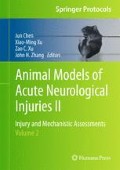Abstract
A wide variety of approaches have been used to help restore locomotor function after spinal cord injury (SCI). In the rat model, these range from biological techniques such as cell transplantation and axon regeneration to retraining methods such as activity-based rehabilitation. Correspondingly, there are many types of behavioral assessments employed to assess functional status and to help determine the best treatment approaches following (SCI). One assessment of locomotor function following SCI in the rat is the Basso, Beattie, and Bresnahan (BBB) scale, which is a categorical scale that subjectively documents limb movements and walking characteristics in an open-field environment. A categorical scale such as this that measures “global” attributes of locomotor ability lends itself well for use as a criterion to determine if an animal is functionally able to participate in other, more objective assessments. The BBB is a useful indicator of the basic overground locomotion of the animal and whether or not the animal would be capable of performing more difficult motor-related assessment tests that require specific abilities (agility, strength, and paw placing), such as the sensorimotor tests of horizontal ladder rung walking or treadmill-based gait analysis. Increasing the number and scope of the assessments performed in addition to the BBB provides a broader view of the functional recovery of animals following a variety of spinal cord injuries/severities and increased sensitivity to functional improvements. The optimal process for increasing the number and types of assessments is the use of dedicated personnel with long-term experience to ensure consistency and reliability in assessment scoring and repeatability. These factors are vital for comparisons within an individual laboratory’s ongoing research and for establishing standardization comparable among outside laboratories.
Access this chapter
Tax calculation will be finalised at checkout
Purchases are for personal use only
References
Talbot JF, Loy DN, Liu Y, Qui MS, Bunge MB, Rao MS, Whittemore SR (2005) Endogenous Nkx2.2+/Olig2+ oligodendrocyte precursor cells fail to remyelinate the demyelinated adult rat spinal cord in the absence of astrocytes. Exp Neurol 192:11–24
Cao Q, He Q, Wang Y, Cheng X, Howard RM, Zhang Y, DeVries WH, Shield CB, Magnuson DS, Xu XM, Kim DH, Whittemore SR (2010) Transplantation of ciliary neurotrophic factor-expressing adult oligodendrocyte precursor cells promotes remyelination and functional recovery after spinal cord injury. J Neurosci 30: 2989–3001
Xu XM, Onifer SM (2009) Transplantation-mediated strategies to promote axonal regeneration following spinal cord injury. Respir Physiol Neurobiol 169:171–182
Smith RR, Burke DA, Baldini AD, Shum-Siu A, Baltzley R, Bunger M, Magnuson DSK (2006) The Louisville swim scale: a novel assessment of hindlimb function following spinal cord injury in adult rats. J Neurotrauma 23(11):1654–1670
Edgerton VR, de Leon RD, Harkema SJ, Hodgson JA, London N, Reinkensmeyer DJ, Roy RR, Talmadge RJ, Tillakaratne NJ, Timoszyk W, Tobin A (2006) Retraining the injured spinal cord. J Physiol 533:15–22
Engesser-Cesar C, Ichiyama RM, Nefas AL, Hill MA, Edgerton VR, Cotman CW, Anderson AJ (2007) Wheel running following spinal cord injury improves locomotor recovery and stimulates serotonergic fiber growth. Eur J Neurosci 25:1931–1939
Muir GD, Webb AA (2000) Mini-review: assessment of behavioural recovery following spinal cord injury in rats. Eur J Neurosci 12:3079–3086
Basso DM, Beattie MS, Bresnahan JC (1995) A sensitive and reliable locomotor rating scale for open field testing in rats. J Neurotrauma 12:1–21
Beare JE, Morehouse JR, DeVries WH, Enzmann GU, Burke DA, Magnuson DSK, Whittemore SR (2009) Gait analysis in normal and spinal contused mice using the TreadScan® system. J Neurotrauma 26:2045–2056
Metz GA, Whishaw IQ (2002) Cortical and subcortical lesions impair skilled walking in the ladder rung walking test: a new task to evaluate fore- and hindlimb stepping, placing, and co-ordination. J Neurosci Methods 115:169–179
Kunkel-Bagden E, Bregman BS (1990) Spinal cord transplants enhance the recovery of locomotor function after spinal cord injury at birth. Exp Brain Res 81:25–34
Basso DM (2004) Behavioral testing after spinal cord injury: congruities, complexities, and controversies. J Neurotrauma 21:395–404
Webb AA, Gowribai K, Muir GD (2003) Fischer (F-344) rats have different morphology, sensorimotor and locomotor abilities compared to Lewis, Long-Evans, Sprague-Dawley and Wistar rats. Behav Brain Res 144:143–156
Mills CD, Hains BC, Johnson KM, Hulsebosch CE (2001) Strain and model differences in behavioral outcomes after spinal cord injury in rat. J Neurotrauma 18(8):743–756
Basso DM and Fisher LC (2003) The Basso mouse scale for locomotion (BMS) is a more sensitive indicator of recovery than the BBB scale in mice with spinal cord injury. J Rehabil Res Dev 40(6), Suppl. 3, 58 (abstract)
Basso DM, Fisher LC, Anderson AJ, Jakeman LB, McTigue DM, Popovich PG (2006) Basso Mouse Scale for locomotion detects differences in recovery after spinal cord injury in five common mouse strains. J Neurotrauma 23(5):635–659
Author information
Authors and Affiliations
Corresponding author
Editor information
Editors and Affiliations
Rights and permissions
Copyright information
© 2012 Springer Science+Business Media, LLC
About this protocol
Cite this protocol
Burke, D.A., Magnuson, D.S.K. (2012). Basso, Beattie, and Bresnahan Scale Locomotor Assessment Following Spinal Cord Injury and Its Utility as a Criterion for Other Assessments. In: Chen, J., Xu, XM., Xu, Z., Zhang, J. (eds) Animal Models of Acute Neurological Injuries II. Springer Protocols Handbooks. Humana Press. https://doi.org/10.1007/978-1-61779-782-8_47
Download citation
DOI: https://doi.org/10.1007/978-1-61779-782-8_47
Published:
Publisher Name: Humana Press
Print ISBN: 978-1-61779-781-1
Online ISBN: 978-1-61779-782-8
eBook Packages: Springer Protocols

